Health Workforce Planning Report: Australia's Healthcare System
VerifiedAdded on 2023/01/16
|11
|2322
|96
Report
AI Summary
This report examines the health workforce planning in Australia, focusing on the country's reliance on foreign-born health workers. It begins by defining the issue and providing a rationale for the study, followed by an environmental scan that highlights the significant dependence on international medical graduates. The discussion section analyzes the current scenario, presenting data on registered medical practitioners, nurses, and midwives, along with their demographics. The report then explores findings from relevant policy and planning documents, the historical development of this reliance, and the sustainability of current policies. The report concludes with recommendations for improvements, including better assessment of health technology, promotion of evidence-based practice, and increased workforce flexibility. The aim is to address the shortage of doctors, promote better patient care, and ensure the sustainability of the healthcare workforce.
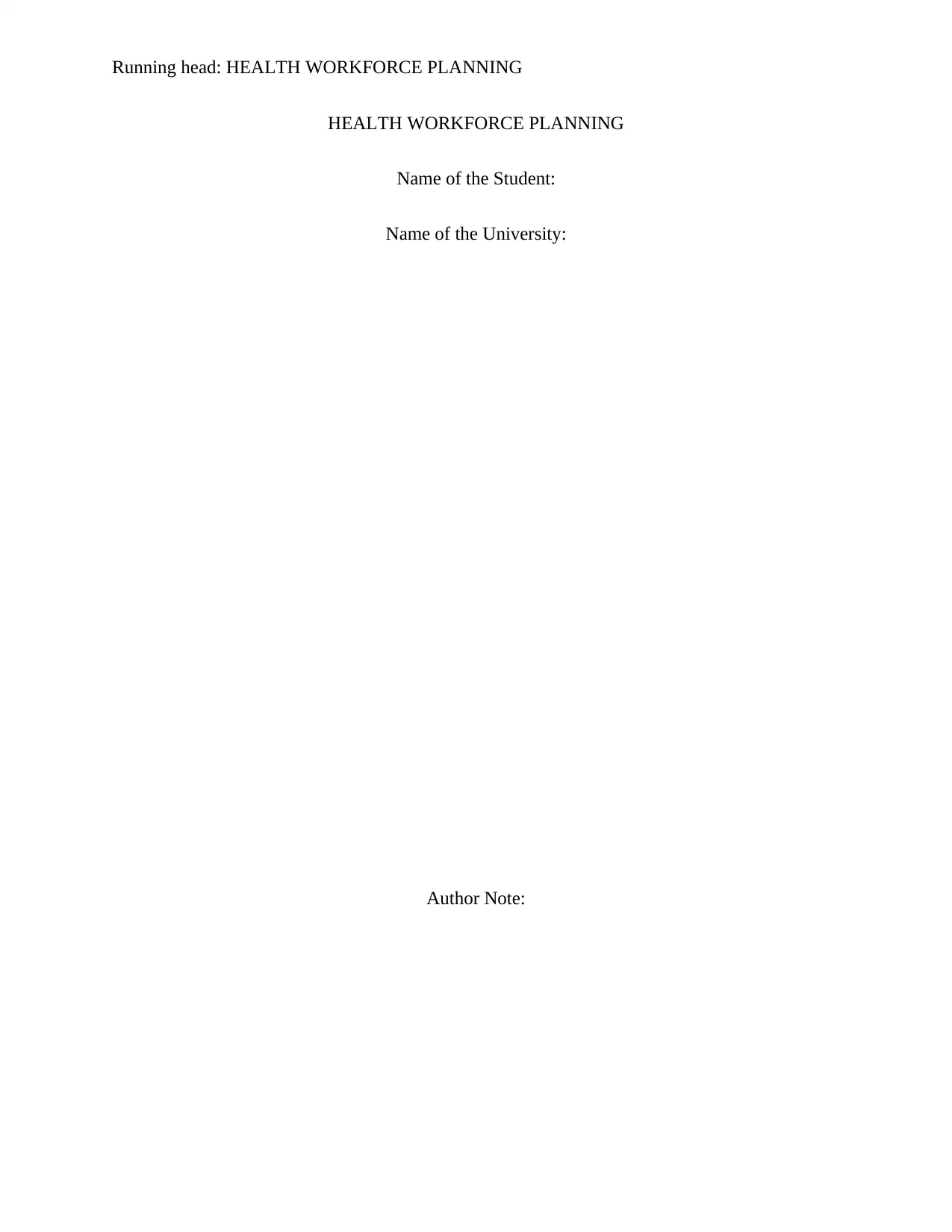
Running head: HEALTH WORKFORCE PLANNING
HEALTH WORKFORCE PLANNING
Name of the Student:
Name of the University:
Author Note:
HEALTH WORKFORCE PLANNING
Name of the Student:
Name of the University:
Author Note:
Paraphrase This Document
Need a fresh take? Get an instant paraphrase of this document with our AI Paraphraser
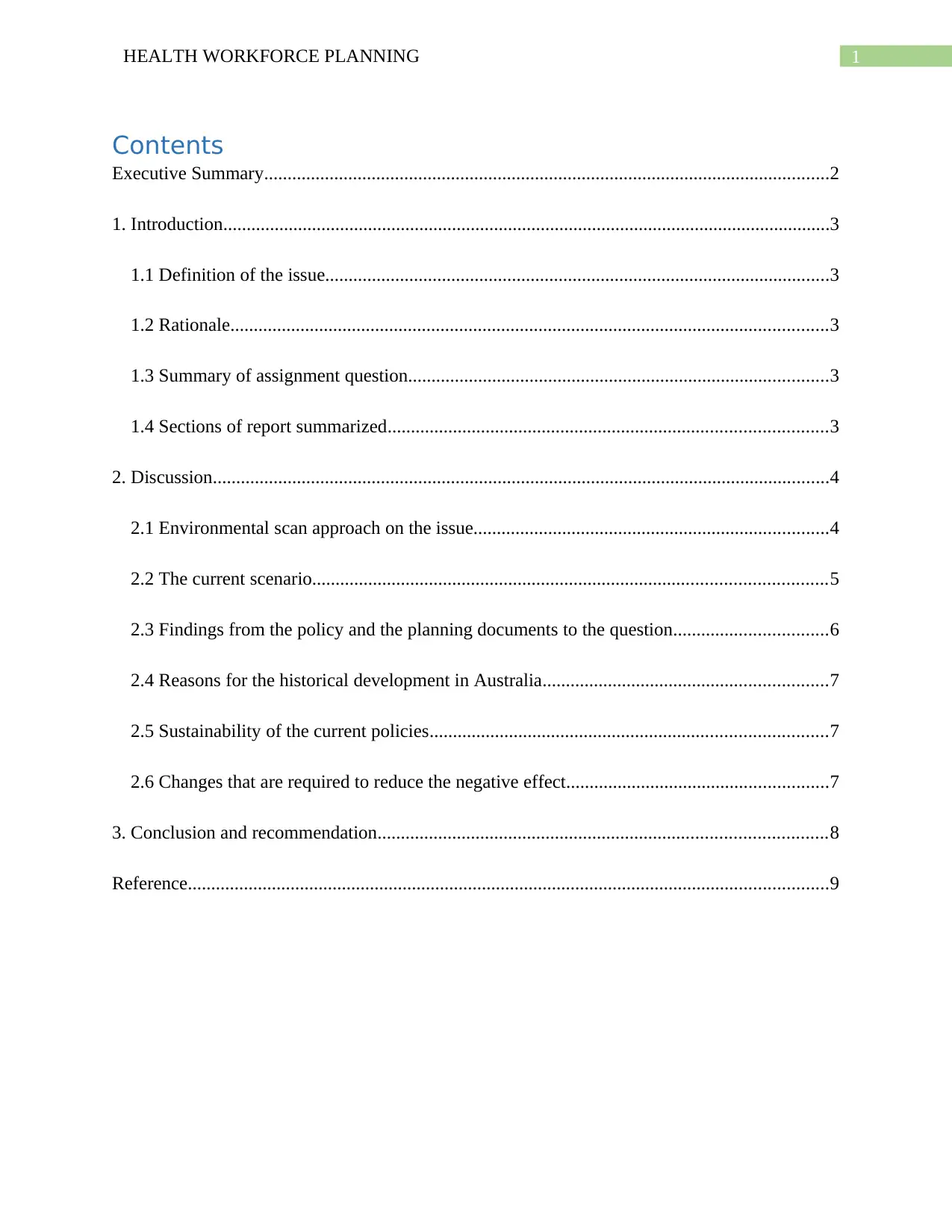
1HEALTH WORKFORCE PLANNING
Contents
Executive Summary.........................................................................................................................2
1. Introduction..................................................................................................................................3
1.1 Definition of the issue............................................................................................................3
1.2 Rationale................................................................................................................................3
1.3 Summary of assignment question..........................................................................................3
1.4 Sections of report summarized..............................................................................................3
2. Discussion....................................................................................................................................4
2.1 Environmental scan approach on the issue............................................................................4
2.2 The current scenario..............................................................................................................5
2.3 Findings from the policy and the planning documents to the question.................................6
2.4 Reasons for the historical development in Australia.............................................................7
2.5 Sustainability of the current policies.....................................................................................7
2.6 Changes that are required to reduce the negative effect........................................................7
3. Conclusion and recommendation................................................................................................8
Reference.........................................................................................................................................9
Contents
Executive Summary.........................................................................................................................2
1. Introduction..................................................................................................................................3
1.1 Definition of the issue............................................................................................................3
1.2 Rationale................................................................................................................................3
1.3 Summary of assignment question..........................................................................................3
1.4 Sections of report summarized..............................................................................................3
2. Discussion....................................................................................................................................4
2.1 Environmental scan approach on the issue............................................................................4
2.2 The current scenario..............................................................................................................5
2.3 Findings from the policy and the planning documents to the question.................................6
2.4 Reasons for the historical development in Australia.............................................................7
2.5 Sustainability of the current policies.....................................................................................7
2.6 Changes that are required to reduce the negative effect........................................................7
3. Conclusion and recommendation................................................................................................8
Reference.........................................................................................................................................9
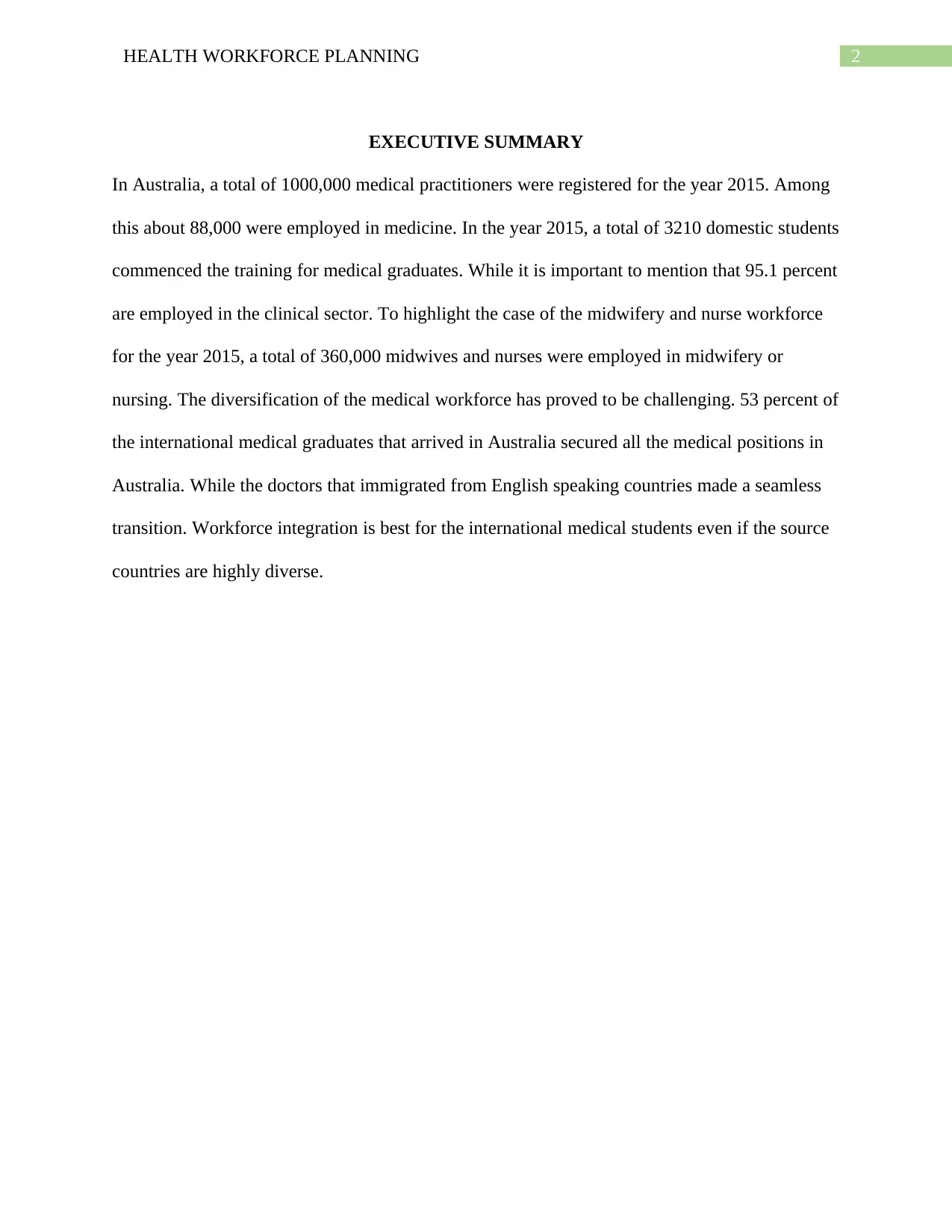
2HEALTH WORKFORCE PLANNING
EXECUTIVE SUMMARY
In Australia, a total of 1000,000 medical practitioners were registered for the year 2015. Among
this about 88,000 were employed in medicine. In the year 2015, a total of 3210 domestic students
commenced the training for medical graduates. While it is important to mention that 95.1 percent
are employed in the clinical sector. To highlight the case of the midwifery and nurse workforce
for the year 2015, a total of 360,000 midwives and nurses were employed in midwifery or
nursing. The diversification of the medical workforce has proved to be challenging. 53 percent of
the international medical graduates that arrived in Australia secured all the medical positions in
Australia. While the doctors that immigrated from English speaking countries made a seamless
transition. Workforce integration is best for the international medical students even if the source
countries are highly diverse.
EXECUTIVE SUMMARY
In Australia, a total of 1000,000 medical practitioners were registered for the year 2015. Among
this about 88,000 were employed in medicine. In the year 2015, a total of 3210 domestic students
commenced the training for medical graduates. While it is important to mention that 95.1 percent
are employed in the clinical sector. To highlight the case of the midwifery and nurse workforce
for the year 2015, a total of 360,000 midwives and nurses were employed in midwifery or
nursing. The diversification of the medical workforce has proved to be challenging. 53 percent of
the international medical graduates that arrived in Australia secured all the medical positions in
Australia. While the doctors that immigrated from English speaking countries made a seamless
transition. Workforce integration is best for the international medical students even if the source
countries are highly diverse.
⊘ This is a preview!⊘
Do you want full access?
Subscribe today to unlock all pages.

Trusted by 1+ million students worldwide
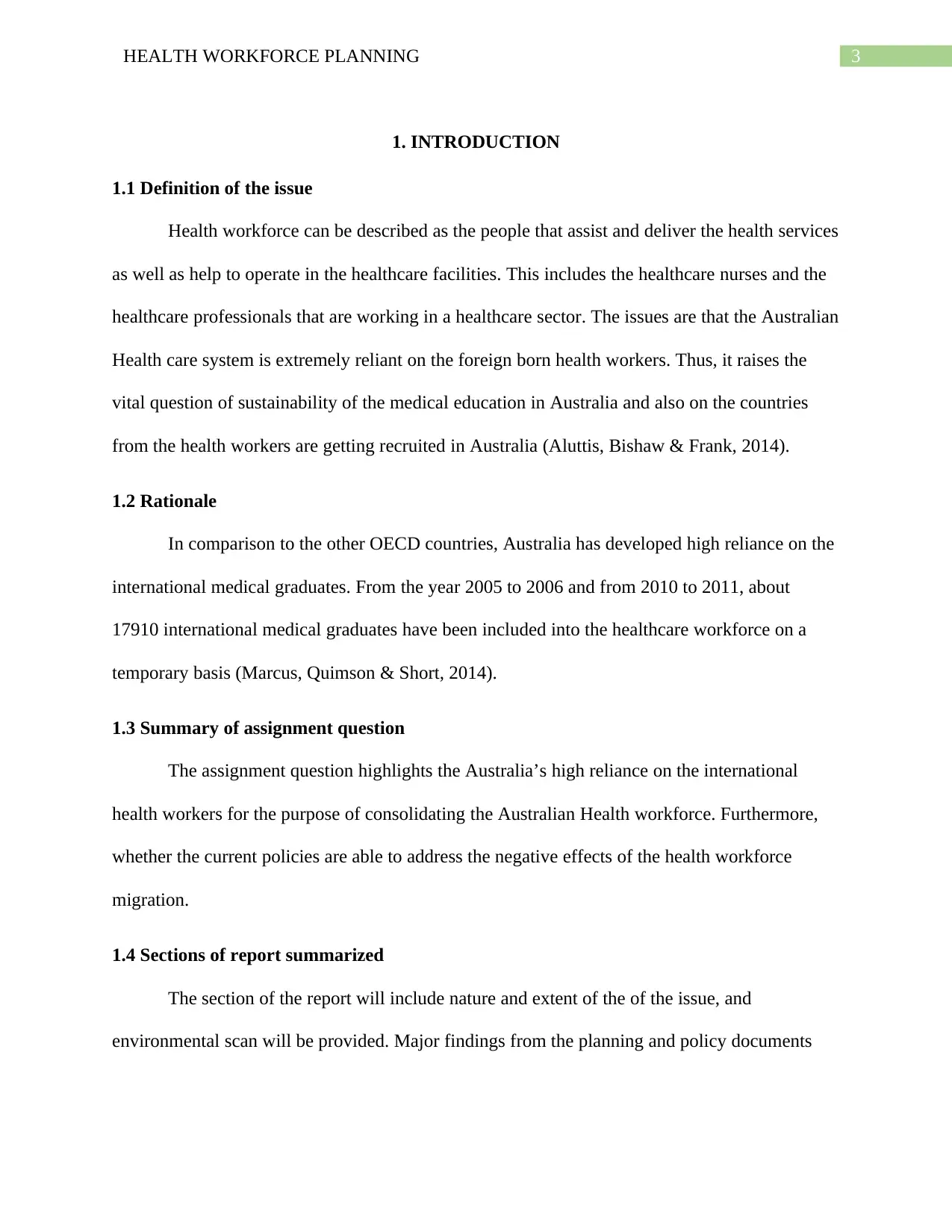
3HEALTH WORKFORCE PLANNING
1. INTRODUCTION
1.1 Definition of the issue
Health workforce can be described as the people that assist and deliver the health services
as well as help to operate in the healthcare facilities. This includes the healthcare nurses and the
healthcare professionals that are working in a healthcare sector. The issues are that the Australian
Health care system is extremely reliant on the foreign born health workers. Thus, it raises the
vital question of sustainability of the medical education in Australia and also on the countries
from the health workers are getting recruited in Australia (Aluttis, Bishaw & Frank, 2014).
1.2 Rationale
In comparison to the other OECD countries, Australia has developed high reliance on the
international medical graduates. From the year 2005 to 2006 and from 2010 to 2011, about
17910 international medical graduates have been included into the healthcare workforce on a
temporary basis (Marcus, Quimson & Short, 2014).
1.3 Summary of assignment question
The assignment question highlights the Australia’s high reliance on the international
health workers for the purpose of consolidating the Australian Health workforce. Furthermore,
whether the current policies are able to address the negative effects of the health workforce
migration.
1.4 Sections of report summarized
The section of the report will include nature and extent of the of the issue, and
environmental scan will be provided. Major findings from the planning and policy documents
1. INTRODUCTION
1.1 Definition of the issue
Health workforce can be described as the people that assist and deliver the health services
as well as help to operate in the healthcare facilities. This includes the healthcare nurses and the
healthcare professionals that are working in a healthcare sector. The issues are that the Australian
Health care system is extremely reliant on the foreign born health workers. Thus, it raises the
vital question of sustainability of the medical education in Australia and also on the countries
from the health workers are getting recruited in Australia (Aluttis, Bishaw & Frank, 2014).
1.2 Rationale
In comparison to the other OECD countries, Australia has developed high reliance on the
international medical graduates. From the year 2005 to 2006 and from 2010 to 2011, about
17910 international medical graduates have been included into the healthcare workforce on a
temporary basis (Marcus, Quimson & Short, 2014).
1.3 Summary of assignment question
The assignment question highlights the Australia’s high reliance on the international
health workers for the purpose of consolidating the Australian Health workforce. Furthermore,
whether the current policies are able to address the negative effects of the health workforce
migration.
1.4 Sections of report summarized
The section of the report will include nature and extent of the of the issue, and
environmental scan will be provided. Major findings from the planning and policy documents
Paraphrase This Document
Need a fresh take? Get an instant paraphrase of this document with our AI Paraphraser
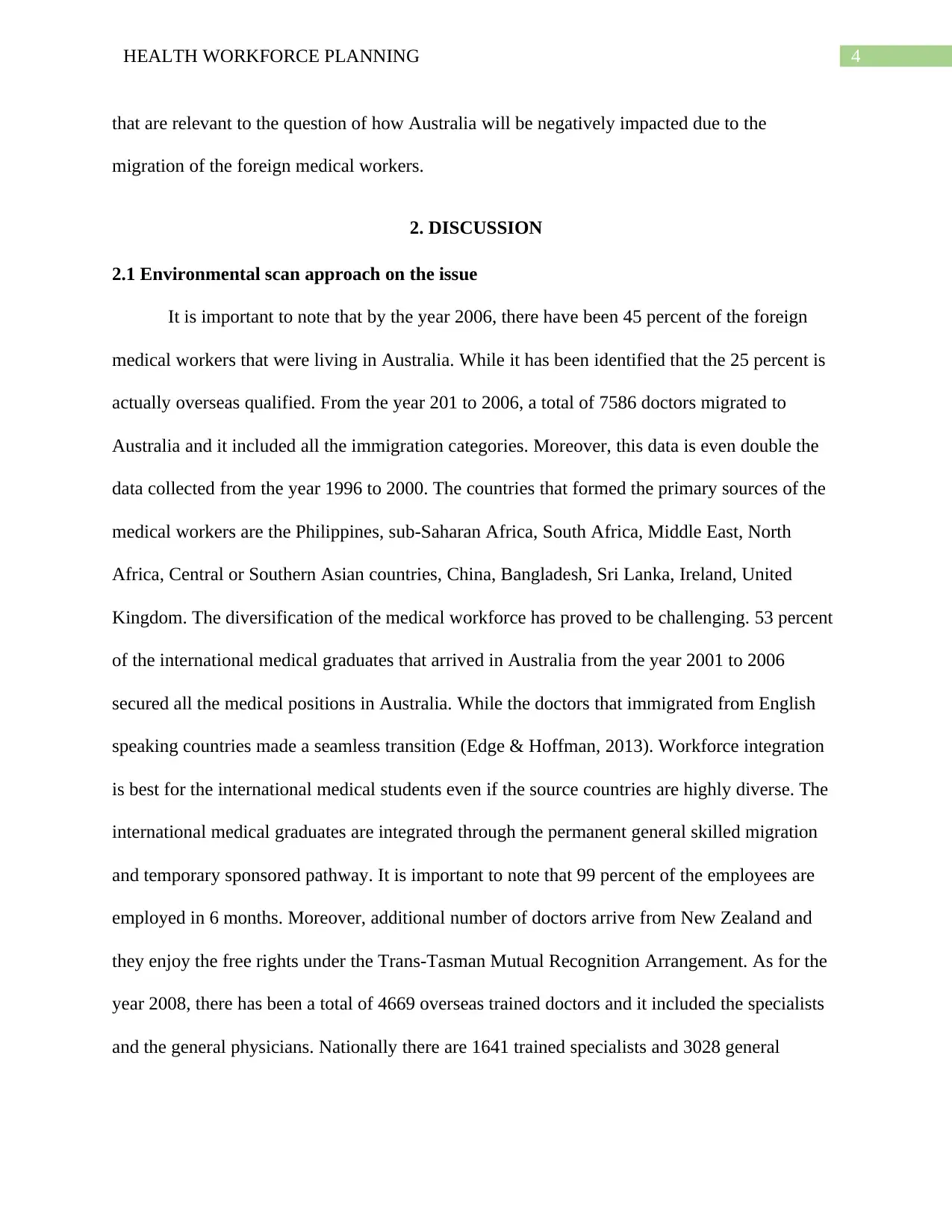
4HEALTH WORKFORCE PLANNING
that are relevant to the question of how Australia will be negatively impacted due to the
migration of the foreign medical workers.
2. DISCUSSION
2.1 Environmental scan approach on the issue
It is important to note that by the year 2006, there have been 45 percent of the foreign
medical workers that were living in Australia. While it has been identified that the 25 percent is
actually overseas qualified. From the year 201 to 2006, a total of 7586 doctors migrated to
Australia and it included all the immigration categories. Moreover, this data is even double the
data collected from the year 1996 to 2000. The countries that formed the primary sources of the
medical workers are the Philippines, sub-Saharan Africa, South Africa, Middle East, North
Africa, Central or Southern Asian countries, China, Bangladesh, Sri Lanka, Ireland, United
Kingdom. The diversification of the medical workforce has proved to be challenging. 53 percent
of the international medical graduates that arrived in Australia from the year 2001 to 2006
secured all the medical positions in Australia. While the doctors that immigrated from English
speaking countries made a seamless transition (Edge & Hoffman, 2013). Workforce integration
is best for the international medical students even if the source countries are highly diverse. The
international medical graduates are integrated through the permanent general skilled migration
and temporary sponsored pathway. It is important to note that 99 percent of the employees are
employed in 6 months. Moreover, additional number of doctors arrive from New Zealand and
they enjoy the free rights under the Trans-Tasman Mutual Recognition Arrangement. As for the
year 2008, there has been a total of 4669 overseas trained doctors and it included the specialists
and the general physicians. Nationally there are 1641 trained specialists and 3028 general
that are relevant to the question of how Australia will be negatively impacted due to the
migration of the foreign medical workers.
2. DISCUSSION
2.1 Environmental scan approach on the issue
It is important to note that by the year 2006, there have been 45 percent of the foreign
medical workers that were living in Australia. While it has been identified that the 25 percent is
actually overseas qualified. From the year 201 to 2006, a total of 7586 doctors migrated to
Australia and it included all the immigration categories. Moreover, this data is even double the
data collected from the year 1996 to 2000. The countries that formed the primary sources of the
medical workers are the Philippines, sub-Saharan Africa, South Africa, Middle East, North
Africa, Central or Southern Asian countries, China, Bangladesh, Sri Lanka, Ireland, United
Kingdom. The diversification of the medical workforce has proved to be challenging. 53 percent
of the international medical graduates that arrived in Australia from the year 2001 to 2006
secured all the medical positions in Australia. While the doctors that immigrated from English
speaking countries made a seamless transition (Edge & Hoffman, 2013). Workforce integration
is best for the international medical students even if the source countries are highly diverse. The
international medical graduates are integrated through the permanent general skilled migration
and temporary sponsored pathway. It is important to note that 99 percent of the employees are
employed in 6 months. Moreover, additional number of doctors arrive from New Zealand and
they enjoy the free rights under the Trans-Tasman Mutual Recognition Arrangement. As for the
year 2008, there has been a total of 4669 overseas trained doctors and it included the specialists
and the general physicians. Nationally there are 1641 trained specialists and 3028 general
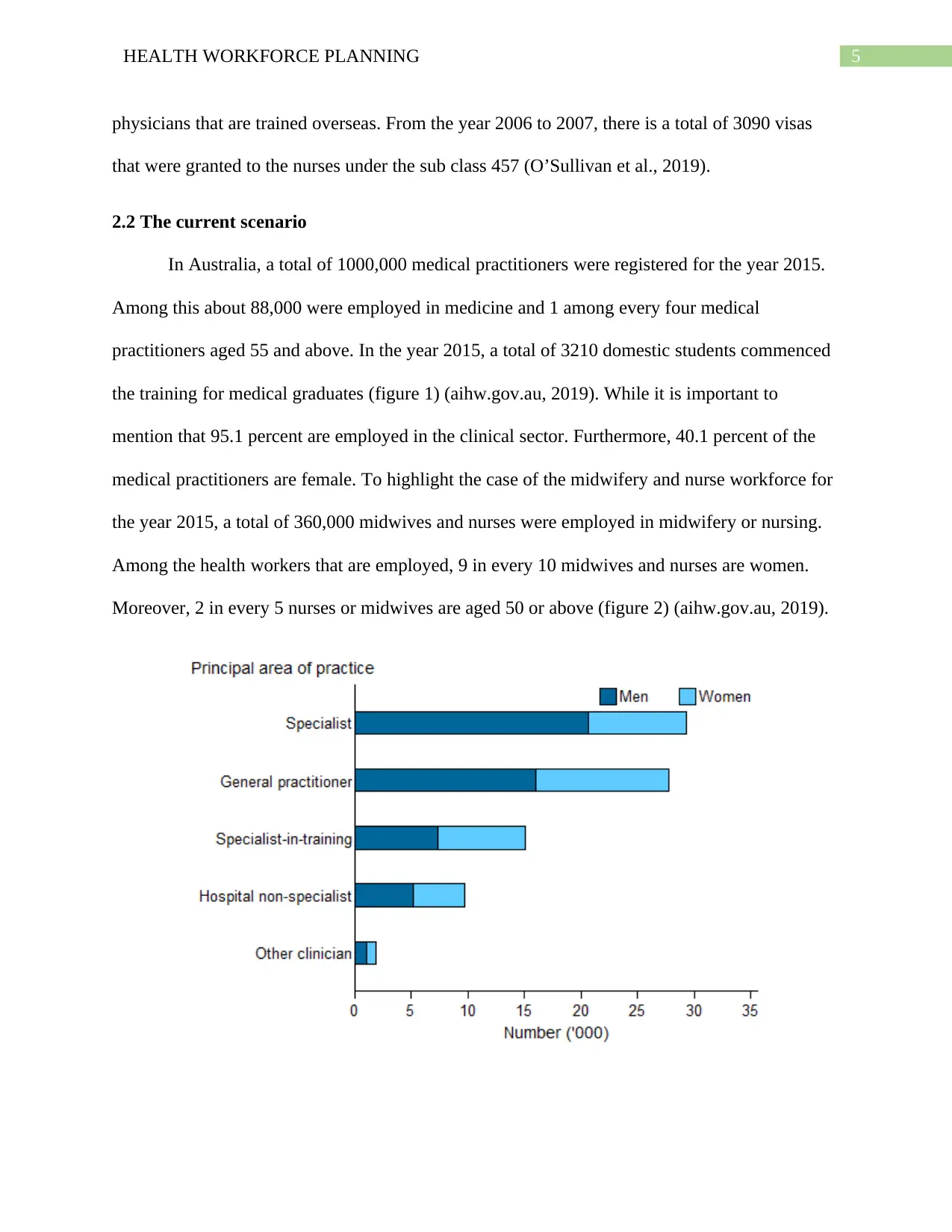
5HEALTH WORKFORCE PLANNING
physicians that are trained overseas. From the year 2006 to 2007, there is a total of 3090 visas
that were granted to the nurses under the sub class 457 (O’Sullivan et al., 2019).
2.2 The current scenario
In Australia, a total of 1000,000 medical practitioners were registered for the year 2015.
Among this about 88,000 were employed in medicine and 1 among every four medical
practitioners aged 55 and above. In the year 2015, a total of 3210 domestic students commenced
the training for medical graduates (figure 1) (aihw.gov.au, 2019). While it is important to
mention that 95.1 percent are employed in the clinical sector. Furthermore, 40.1 percent of the
medical practitioners are female. To highlight the case of the midwifery and nurse workforce for
the year 2015, a total of 360,000 midwives and nurses were employed in midwifery or nursing.
Among the health workers that are employed, 9 in every 10 midwives and nurses are women.
Moreover, 2 in every 5 nurses or midwives are aged 50 or above (figure 2) (aihw.gov.au, 2019).
physicians that are trained overseas. From the year 2006 to 2007, there is a total of 3090 visas
that were granted to the nurses under the sub class 457 (O’Sullivan et al., 2019).
2.2 The current scenario
In Australia, a total of 1000,000 medical practitioners were registered for the year 2015.
Among this about 88,000 were employed in medicine and 1 among every four medical
practitioners aged 55 and above. In the year 2015, a total of 3210 domestic students commenced
the training for medical graduates (figure 1) (aihw.gov.au, 2019). While it is important to
mention that 95.1 percent are employed in the clinical sector. Furthermore, 40.1 percent of the
medical practitioners are female. To highlight the case of the midwifery and nurse workforce for
the year 2015, a total of 360,000 midwives and nurses were employed in midwifery or nursing.
Among the health workers that are employed, 9 in every 10 midwives and nurses are women.
Moreover, 2 in every 5 nurses or midwives are aged 50 or above (figure 2) (aihw.gov.au, 2019).
⊘ This is a preview!⊘
Do you want full access?
Subscribe today to unlock all pages.

Trusted by 1+ million students worldwide
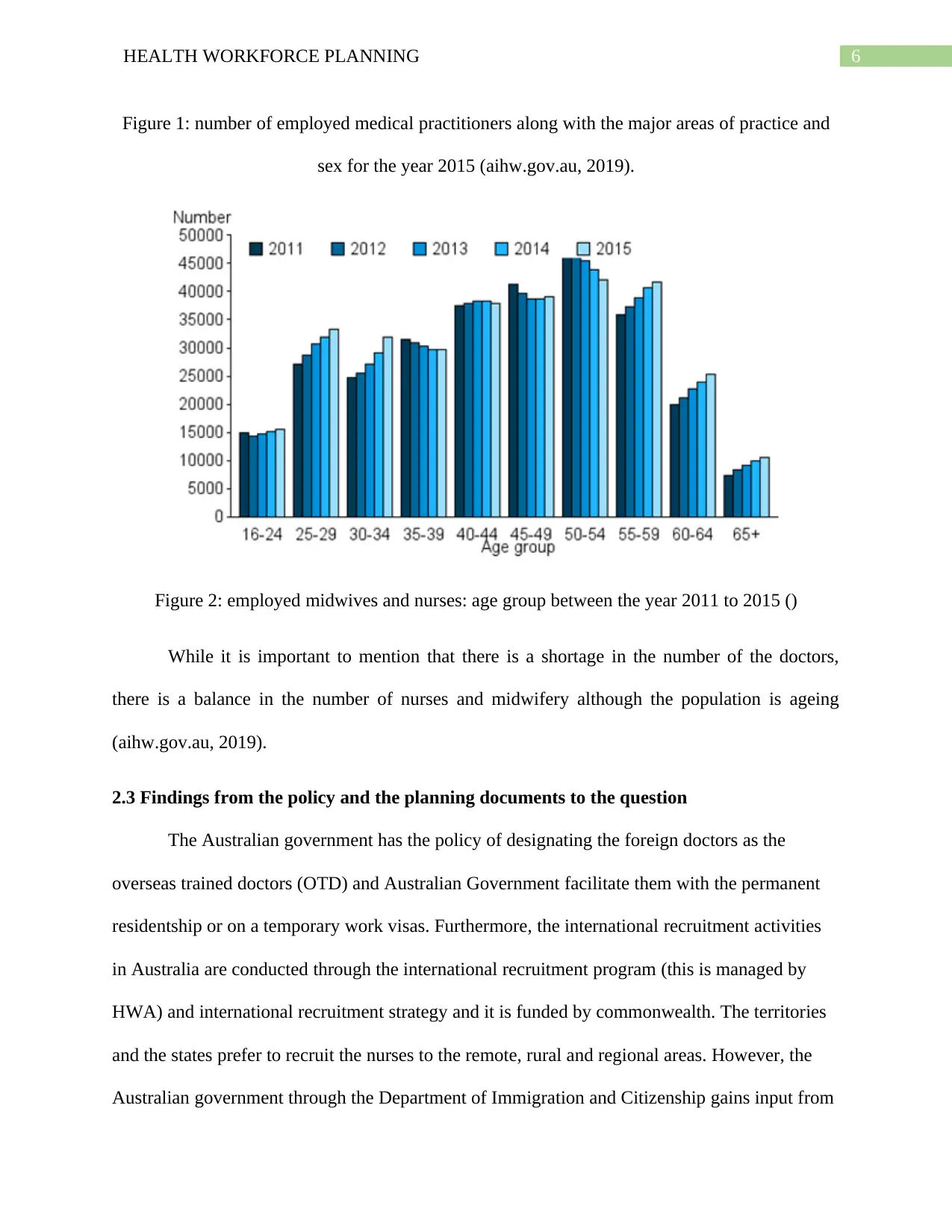
6HEALTH WORKFORCE PLANNING
Figure 1: number of employed medical practitioners along with the major areas of practice and
sex for the year 2015 (aihw.gov.au, 2019).
Figure 2: employed midwives and nurses: age group between the year 2011 to 2015 ()
While it is important to mention that there is a shortage in the number of the doctors,
there is a balance in the number of nurses and midwifery although the population is ageing
(aihw.gov.au, 2019).
2.3 Findings from the policy and the planning documents to the question
The Australian government has the policy of designating the foreign doctors as the
overseas trained doctors (OTD) and Australian Government facilitate them with the permanent
residentship or on a temporary work visas. Furthermore, the international recruitment activities
in Australia are conducted through the international recruitment program (this is managed by
HWA) and international recruitment strategy and it is funded by commonwealth. The territories
and the states prefer to recruit the nurses to the remote, rural and regional areas. However, the
Australian government through the Department of Immigration and Citizenship gains input from
Figure 1: number of employed medical practitioners along with the major areas of practice and
sex for the year 2015 (aihw.gov.au, 2019).
Figure 2: employed midwives and nurses: age group between the year 2011 to 2015 ()
While it is important to mention that there is a shortage in the number of the doctors,
there is a balance in the number of nurses and midwifery although the population is ageing
(aihw.gov.au, 2019).
2.3 Findings from the policy and the planning documents to the question
The Australian government has the policy of designating the foreign doctors as the
overseas trained doctors (OTD) and Australian Government facilitate them with the permanent
residentship or on a temporary work visas. Furthermore, the international recruitment activities
in Australia are conducted through the international recruitment program (this is managed by
HWA) and international recruitment strategy and it is funded by commonwealth. The territories
and the states prefer to recruit the nurses to the remote, rural and regional areas. However, the
Australian government through the Department of Immigration and Citizenship gains input from
Paraphrase This Document
Need a fresh take? Get an instant paraphrase of this document with our AI Paraphraser
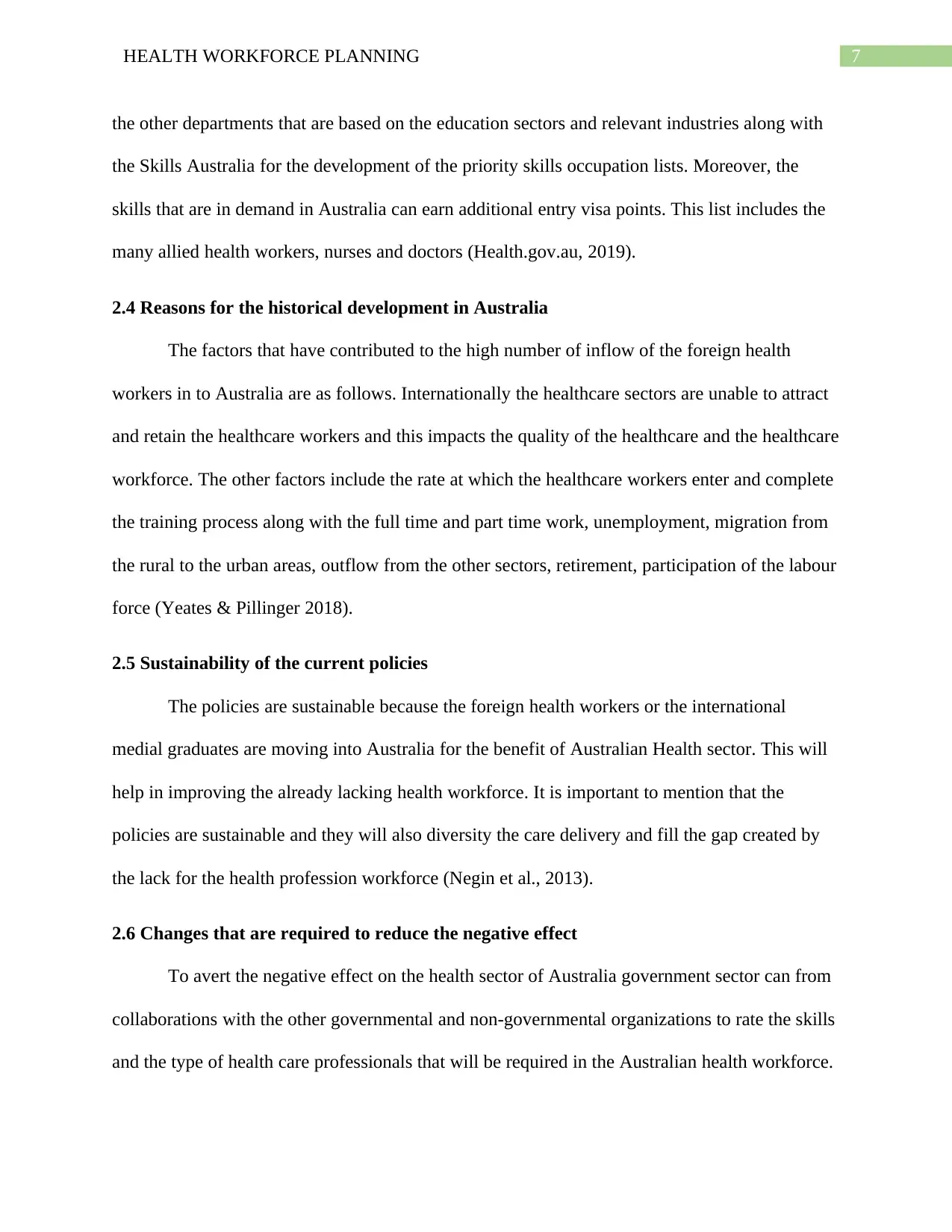
7HEALTH WORKFORCE PLANNING
the other departments that are based on the education sectors and relevant industries along with
the Skills Australia for the development of the priority skills occupation lists. Moreover, the
skills that are in demand in Australia can earn additional entry visa points. This list includes the
many allied health workers, nurses and doctors (Health.gov.au, 2019).
2.4 Reasons for the historical development in Australia
The factors that have contributed to the high number of inflow of the foreign health
workers in to Australia are as follows. Internationally the healthcare sectors are unable to attract
and retain the healthcare workers and this impacts the quality of the healthcare and the healthcare
workforce. The other factors include the rate at which the healthcare workers enter and complete
the training process along with the full time and part time work, unemployment, migration from
the rural to the urban areas, outflow from the other sectors, retirement, participation of the labour
force (Yeates & Pillinger 2018).
2.5 Sustainability of the current policies
The policies are sustainable because the foreign health workers or the international
medial graduates are moving into Australia for the benefit of Australian Health sector. This will
help in improving the already lacking health workforce. It is important to mention that the
policies are sustainable and they will also diversity the care delivery and fill the gap created by
the lack for the health profession workforce (Negin et al., 2013).
2.6 Changes that are required to reduce the negative effect
To avert the negative effect on the health sector of Australia government sector can from
collaborations with the other governmental and non-governmental organizations to rate the skills
and the type of health care professionals that will be required in the Australian health workforce.
the other departments that are based on the education sectors and relevant industries along with
the Skills Australia for the development of the priority skills occupation lists. Moreover, the
skills that are in demand in Australia can earn additional entry visa points. This list includes the
many allied health workers, nurses and doctors (Health.gov.au, 2019).
2.4 Reasons for the historical development in Australia
The factors that have contributed to the high number of inflow of the foreign health
workers in to Australia are as follows. Internationally the healthcare sectors are unable to attract
and retain the healthcare workers and this impacts the quality of the healthcare and the healthcare
workforce. The other factors include the rate at which the healthcare workers enter and complete
the training process along with the full time and part time work, unemployment, migration from
the rural to the urban areas, outflow from the other sectors, retirement, participation of the labour
force (Yeates & Pillinger 2018).
2.5 Sustainability of the current policies
The policies are sustainable because the foreign health workers or the international
medial graduates are moving into Australia for the benefit of Australian Health sector. This will
help in improving the already lacking health workforce. It is important to mention that the
policies are sustainable and they will also diversity the care delivery and fill the gap created by
the lack for the health profession workforce (Negin et al., 2013).
2.6 Changes that are required to reduce the negative effect
To avert the negative effect on the health sector of Australia government sector can from
collaborations with the other governmental and non-governmental organizations to rate the skills
and the type of health care professionals that will be required in the Australian health workforce.
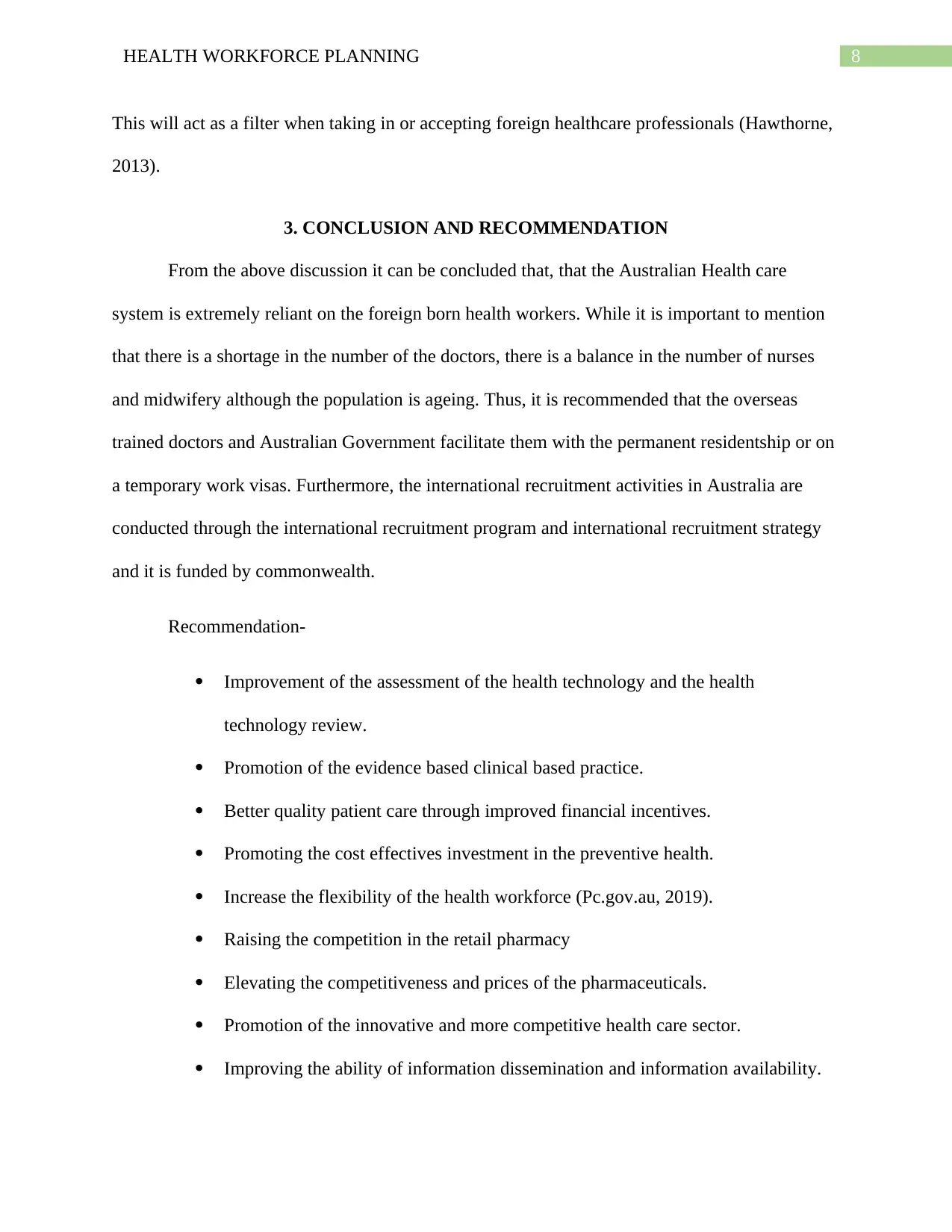
8HEALTH WORKFORCE PLANNING
This will act as a filter when taking in or accepting foreign healthcare professionals (Hawthorne,
2013).
3. CONCLUSION AND RECOMMENDATION
From the above discussion it can be concluded that, that the Australian Health care
system is extremely reliant on the foreign born health workers. While it is important to mention
that there is a shortage in the number of the doctors, there is a balance in the number of nurses
and midwifery although the population is ageing. Thus, it is recommended that the overseas
trained doctors and Australian Government facilitate them with the permanent residentship or on
a temporary work visas. Furthermore, the international recruitment activities in Australia are
conducted through the international recruitment program and international recruitment strategy
and it is funded by commonwealth.
Recommendation-
Improvement of the assessment of the health technology and the health
technology review.
Promotion of the evidence based clinical based practice.
Better quality patient care through improved financial incentives.
Promoting the cost effectives investment in the preventive health.
Increase the flexibility of the health workforce (Pc.gov.au, 2019).
Raising the competition in the retail pharmacy
Elevating the competitiveness and prices of the pharmaceuticals.
Promotion of the innovative and more competitive health care sector.
Improving the ability of information dissemination and information availability.
This will act as a filter when taking in or accepting foreign healthcare professionals (Hawthorne,
2013).
3. CONCLUSION AND RECOMMENDATION
From the above discussion it can be concluded that, that the Australian Health care
system is extremely reliant on the foreign born health workers. While it is important to mention
that there is a shortage in the number of the doctors, there is a balance in the number of nurses
and midwifery although the population is ageing. Thus, it is recommended that the overseas
trained doctors and Australian Government facilitate them with the permanent residentship or on
a temporary work visas. Furthermore, the international recruitment activities in Australia are
conducted through the international recruitment program and international recruitment strategy
and it is funded by commonwealth.
Recommendation-
Improvement of the assessment of the health technology and the health
technology review.
Promotion of the evidence based clinical based practice.
Better quality patient care through improved financial incentives.
Promoting the cost effectives investment in the preventive health.
Increase the flexibility of the health workforce (Pc.gov.au, 2019).
Raising the competition in the retail pharmacy
Elevating the competitiveness and prices of the pharmaceuticals.
Promotion of the innovative and more competitive health care sector.
Improving the ability of information dissemination and information availability.
⊘ This is a preview!⊘
Do you want full access?
Subscribe today to unlock all pages.

Trusted by 1+ million students worldwide
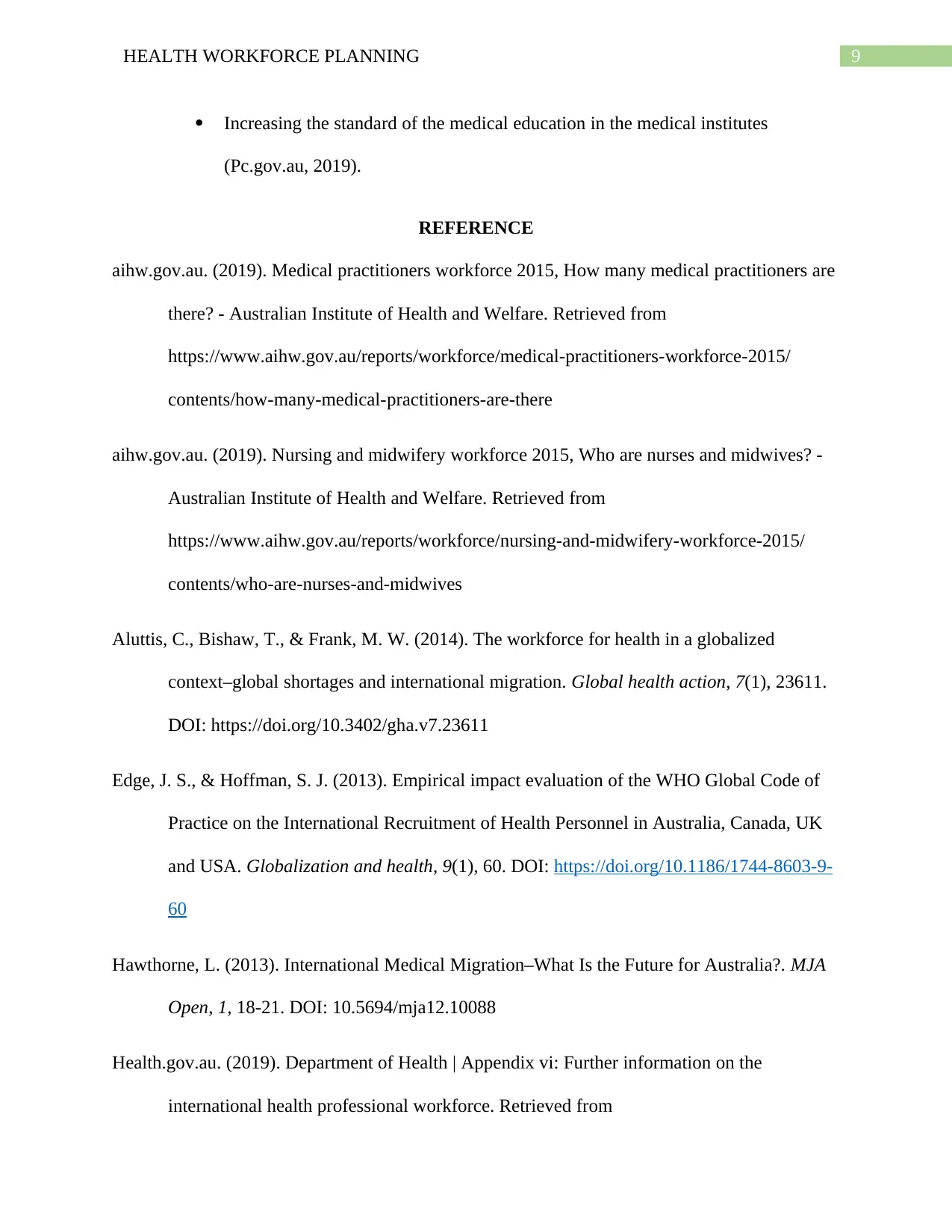
9HEALTH WORKFORCE PLANNING
Increasing the standard of the medical education in the medical institutes
(Pc.gov.au, 2019).
REFERENCE
aihw.gov.au. (2019). Medical practitioners workforce 2015, How many medical practitioners are
there? - Australian Institute of Health and Welfare. Retrieved from
https://www.aihw.gov.au/reports/workforce/medical-practitioners-workforce-2015/
contents/how-many-medical-practitioners-are-there
aihw.gov.au. (2019). Nursing and midwifery workforce 2015, Who are nurses and midwives? -
Australian Institute of Health and Welfare. Retrieved from
https://www.aihw.gov.au/reports/workforce/nursing-and-midwifery-workforce-2015/
contents/who-are-nurses-and-midwives
Aluttis, C., Bishaw, T., & Frank, M. W. (2014). The workforce for health in a globalized
context–global shortages and international migration. Global health action, 7(1), 23611.
DOI: https://doi.org/10.3402/gha.v7.23611
Edge, J. S., & Hoffman, S. J. (2013). Empirical impact evaluation of the WHO Global Code of
Practice on the International Recruitment of Health Personnel in Australia, Canada, UK
and USA. Globalization and health, 9(1), 60. DOI: https://doi.org/10.1186/1744-8603-9-
60
Hawthorne, L. (2013). International Medical Migration–What Is the Future for Australia?. MJA
Open, 1, 18-21. DOI: 10.5694/mja12.10088
Health.gov.au. (2019). Department of Health | Appendix vi: Further information on the
international health professional workforce. Retrieved from
Increasing the standard of the medical education in the medical institutes
(Pc.gov.au, 2019).
REFERENCE
aihw.gov.au. (2019). Medical practitioners workforce 2015, How many medical practitioners are
there? - Australian Institute of Health and Welfare. Retrieved from
https://www.aihw.gov.au/reports/workforce/medical-practitioners-workforce-2015/
contents/how-many-medical-practitioners-are-there
aihw.gov.au. (2019). Nursing and midwifery workforce 2015, Who are nurses and midwives? -
Australian Institute of Health and Welfare. Retrieved from
https://www.aihw.gov.au/reports/workforce/nursing-and-midwifery-workforce-2015/
contents/who-are-nurses-and-midwives
Aluttis, C., Bishaw, T., & Frank, M. W. (2014). The workforce for health in a globalized
context–global shortages and international migration. Global health action, 7(1), 23611.
DOI: https://doi.org/10.3402/gha.v7.23611
Edge, J. S., & Hoffman, S. J. (2013). Empirical impact evaluation of the WHO Global Code of
Practice on the International Recruitment of Health Personnel in Australia, Canada, UK
and USA. Globalization and health, 9(1), 60. DOI: https://doi.org/10.1186/1744-8603-9-
60
Hawthorne, L. (2013). International Medical Migration–What Is the Future for Australia?. MJA
Open, 1, 18-21. DOI: 10.5694/mja12.10088
Health.gov.au. (2019). Department of Health | Appendix vi: Further information on the
international health professional workforce. Retrieved from
Paraphrase This Document
Need a fresh take? Get an instant paraphrase of this document with our AI Paraphraser
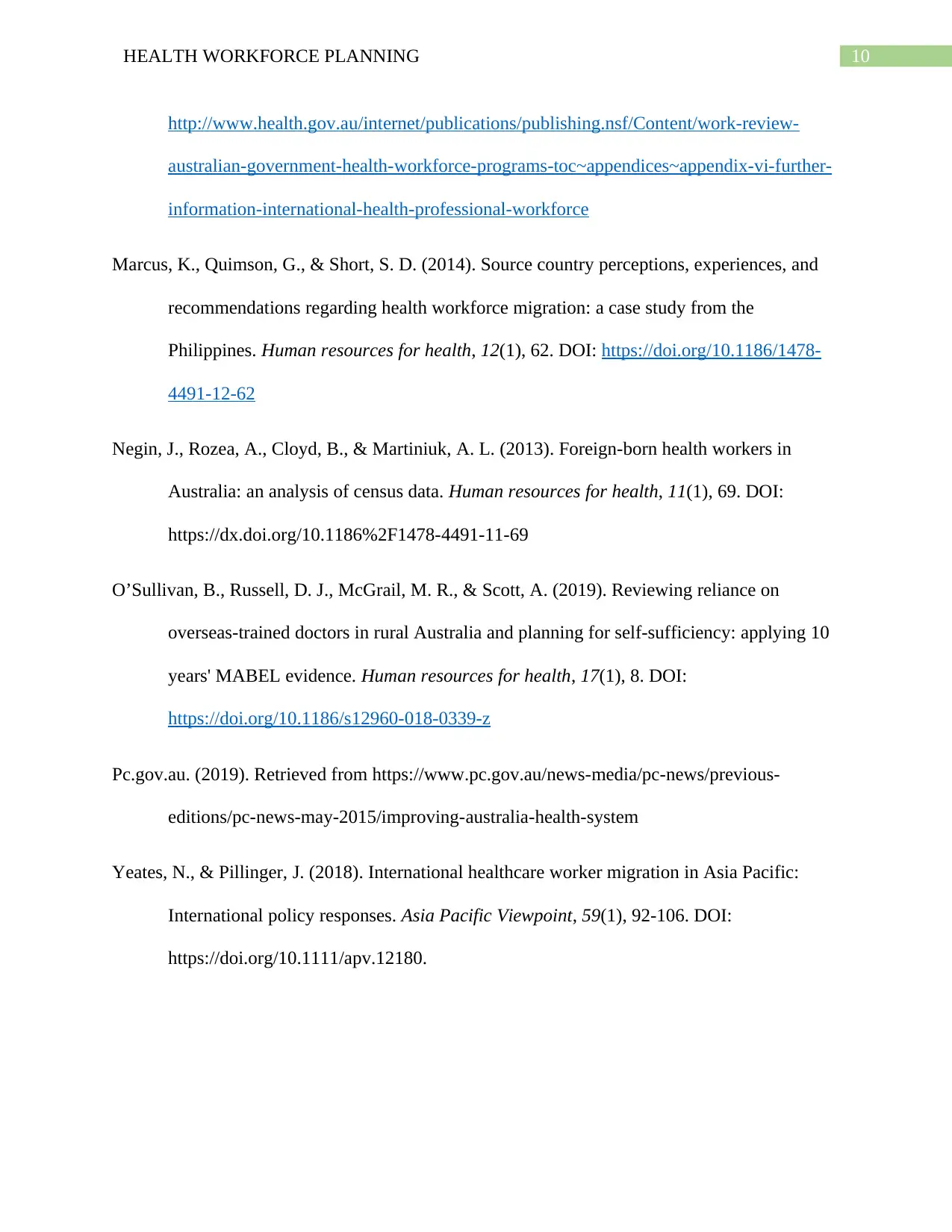
10HEALTH WORKFORCE PLANNING
http://www.health.gov.au/internet/publications/publishing.nsf/Content/work-review-
australian-government-health-workforce-programs-toc~appendices~appendix-vi-further-
information-international-health-professional-workforce
Marcus, K., Quimson, G., & Short, S. D. (2014). Source country perceptions, experiences, and
recommendations regarding health workforce migration: a case study from the
Philippines. Human resources for health, 12(1), 62. DOI: https://doi.org/10.1186/1478-
4491-12-62
Negin, J., Rozea, A., Cloyd, B., & Martiniuk, A. L. (2013). Foreign-born health workers in
Australia: an analysis of census data. Human resources for health, 11(1), 69. DOI:
https://dx.doi.org/10.1186%2F1478-4491-11-69
O’Sullivan, B., Russell, D. J., McGrail, M. R., & Scott, A. (2019). Reviewing reliance on
overseas-trained doctors in rural Australia and planning for self-sufficiency: applying 10
years' MABEL evidence. Human resources for health, 17(1), 8. DOI:
https://doi.org/10.1186/s12960-018-0339-z
Pc.gov.au. (2019). Retrieved from https://www.pc.gov.au/news-media/pc-news/previous-
editions/pc-news-may-2015/improving-australia-health-system
Yeates, N., & Pillinger, J. (2018). International healthcare worker migration in Asia Pacific:
International policy responses. Asia Pacific Viewpoint, 59(1), 92-106. DOI:
https://doi.org/10.1111/apv.12180.
http://www.health.gov.au/internet/publications/publishing.nsf/Content/work-review-
australian-government-health-workforce-programs-toc~appendices~appendix-vi-further-
information-international-health-professional-workforce
Marcus, K., Quimson, G., & Short, S. D. (2014). Source country perceptions, experiences, and
recommendations regarding health workforce migration: a case study from the
Philippines. Human resources for health, 12(1), 62. DOI: https://doi.org/10.1186/1478-
4491-12-62
Negin, J., Rozea, A., Cloyd, B., & Martiniuk, A. L. (2013). Foreign-born health workers in
Australia: an analysis of census data. Human resources for health, 11(1), 69. DOI:
https://dx.doi.org/10.1186%2F1478-4491-11-69
O’Sullivan, B., Russell, D. J., McGrail, M. R., & Scott, A. (2019). Reviewing reliance on
overseas-trained doctors in rural Australia and planning for self-sufficiency: applying 10
years' MABEL evidence. Human resources for health, 17(1), 8. DOI:
https://doi.org/10.1186/s12960-018-0339-z
Pc.gov.au. (2019). Retrieved from https://www.pc.gov.au/news-media/pc-news/previous-
editions/pc-news-may-2015/improving-australia-health-system
Yeates, N., & Pillinger, J. (2018). International healthcare worker migration in Asia Pacific:
International policy responses. Asia Pacific Viewpoint, 59(1), 92-106. DOI:
https://doi.org/10.1111/apv.12180.
1 out of 11
Related Documents
Your All-in-One AI-Powered Toolkit for Academic Success.
+13062052269
info@desklib.com
Available 24*7 on WhatsApp / Email
![[object Object]](/_next/static/media/star-bottom.7253800d.svg)
Unlock your academic potential
Copyright © 2020–2025 A2Z Services. All Rights Reserved. Developed and managed by ZUCOL.





